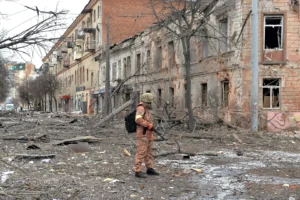The National Weather Service received 33 tornado reports across southern states like Alabama, Georgia and Kentucky.
A “large and extremely dangerous tornado” ripped across central Alabama on Thursday, part of a line of storms that have slammed the southeastern United States.
No deaths have been reported so far but the enormous, swirling weather system destroyed homes, toppled trees and trapped at least one resident in the rubble as it passed through the historic city of Selma, a centre for the 1960s civil rights movement.
“A tornado has definitely damaged Selma,” former state Senator Hank Sanders told the Associated Press. “In fact, it hit our house but not head-on. It blew out windows in the bedroom and in the living room. It is raining through the roof in the kitchen.”
The incident was one of 33 tornado reports received by the National Weather Service on Thursday, including a confirmed touchdown in Kentucky and sightings near Atlanta’s Hartsfield-Jackson International Airport, the world’s busiest air terminal for passenger traffic.
Warnings remain in effect for states like North Carolina, South Carolina and Georgia.
The National Weather Service in Birmingham, Alabama, issued a statement saying it had received “a lot of devastating reports of damage” and asked residents to avoid areas of devastation so first responders could handle any emergencies.
One Selma resident, Bobby Green, found himself trapped in his car during the tornado, as debris rained down on its roof. He told the local news station WVTM that he tried to flee to a nearby store but the wind was so strong that it blew the car door shut. It all happened fast, he said.
“I thought it was all over for me,” Green explained. “All the rubble was on top of me and I had to climb out of the passenger side window.”
Selma Mayor James Perkins announced that a city curfew would be in effect on Thursday as the city assessed the damage.
“People have been injured but no fatalities,” Perkins said. “We have a lot of downed power lines. There is a lot of danger on the streets.”
An estimated 50,000 people were left without power across the state, according to PowerOutage.us, a website that tracks outages.
Selma, a city of about 18,000 residents, sits in a region in the south known as the Black Belt, named in part for its African American history. It was there that Martin Luther King Jr and other civil rights leaders in the 1960s launched nonviolent marches, walking 87 km (54 miles) to the state capital of Montgomery.
Many of the sites associated with Selma’s civil rights history are fragile and in need of repair, including the 114-year-old Brown Chapel AME Church. Protesters in 1965 used the church as a base of operations as they prepared to march, leading to an incident called “Bloody Sunday”.
Police with nightsticks, tear gas and other weapons attacked the marchers that day, one of whom was the late John Lewis, a future US Senator whose skull was fractured in the violence.
The incident was broadcast across the country and is credited with leading to the passage of the Voting Rights Act later that year, which prohibited discrimination at the polls.
The historically Black church was in the midst of a $1.3m renovation through the US National Park Service at the time of the tornado.
Source : Aljazeera















